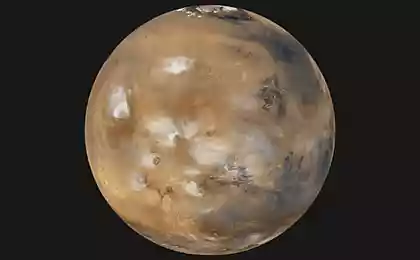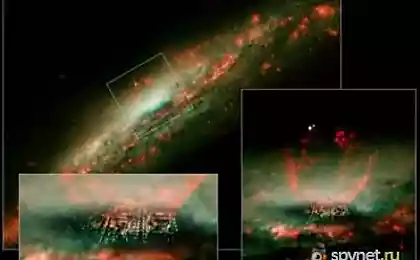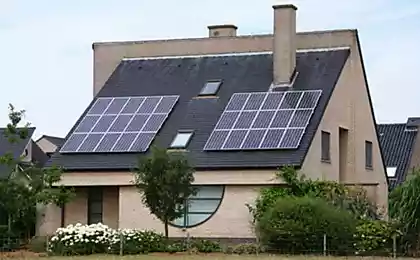931
10 unsolved mysteries of the Solar system

Despite the fact that humanity is due to powerful telescopes and numerous space missions learned a lot of interesting things about our Solar system, there are still many questions and mysteries that baffled even the most eminent scientists of our time. And the more we study space, the more mysteries he presents us. To discover the ten most interesting mysteries of our Solar system that have not yet been able to solve even the best minds on the planet.
Invisible shield surrounding Earth
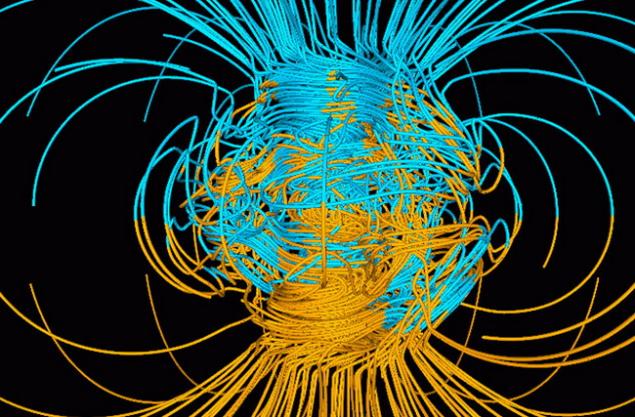
In 1958, James van Allen from the University of Iowa discovered a pair of radiation of rings girdling the planet at altitudes of up to 40,000 km and consisting of electrons and protons of high energies. Keeps the rings around our planet Earth's magnetic field. Observation of the rings showed that they then compress, then expand under the influence of the energy emitted by solar flares.
In 2013, Daniel Baker of the University of Colorado found between the inner and outer radiation of the van Allen rings the third structure. Baker identified this structure as a "storage ring", working as a widening and a narrowing invisible shield that blocks the effects of the "deadly" electron. These electrons, located at an altitude of 16,000 kilometers, can be disastrous not only for people in space, but also for various equipment of space satellites.
At a height of just over 11 000 kilometres above the planet's surface formed the boundary of the inner ring, whose outer contour blocks the electrons and prevents them to penetrate deeper into our atmosphere.
"These electrons if faced with a glass wall. Something around our planet creates a kind of force field, which we might see in various science fiction films. This is an incredibly mysterious phenomenon," says Baker. Scientists have developed several theories that in one way or another might partly explain the essence of the invisible shield. However, none of these theories is not final and confirmed.
Anomaly acceleration
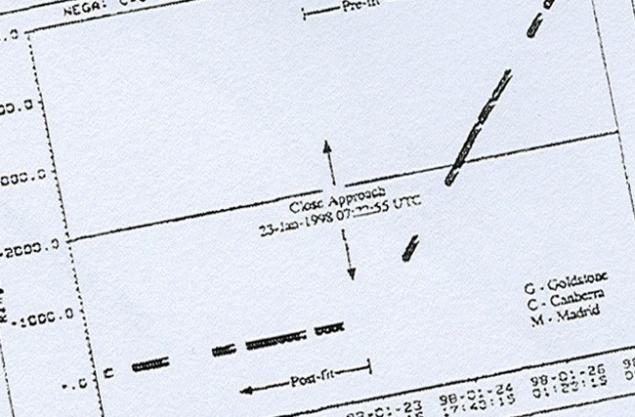
For sending spacecraft to the furthest reaches of our Solar system, scientists use a special gravitational maneuvers using gravitational energy of the planet or moon to accelerate. However, scientists, as it turns out, is not always able to accurately calculate the rate of acceleration of the spacecraft during such maneuvers. Sometimes it happens that the calculated speed does not match the previously stated. Such discrepancies are called "anomalous acceleration".
Now scientists have the opportunity to only calculate the exact difference in speed during acceleration due to the gravitational energy of the Earth. However, even in this case there is an unexpected event, such as happened with NASA's Cassini in 1999, whose speed of flight due to strange circumstances, it was delayed by 2 millimeters per second. Another case occurred in 1998, when the spacecraft is NEAR the same NASA received an unexplained acceleration of 13 millimeters per second is higher compared to the previously stated calculations.
"These unexplained differences in calculated and actual speed do not play a major role in changing the trajectory of the spacecraft," says Louis Bathrooms Rodriguez, a physicist from the Polytechnic University of Valencia."And although these abnormal differences are found not so often, considering all the risks, it is very important to know what they are called". Scientists have offered various theories about what can be caused by these anomalies. In the perpetrators and put solar radiation, and dark matter captured by the gravity of the planet, but the exact cause of this phenomenon, nobody knows. Still.
The great red spot of Jupiter

With a big red spot on Jupiter, the fifth planet from the Sun, is due just two unresolved mysteries. The first mystery is the fact why this giant hurricane that never stops? It's so big that inside of it could fit at least two planets the size of our Earth.
"According to current theories, the great red spot on Jupiter was supposed to disappear after a few decades. However, this storm lasts for several centuries," says Pedram hassanzadeh of Harvard University. There are several theories that attempt to explain it so long. According to one of these theories, long-lived giant hurricane absorbs smaller tornadoes formed near, absorbing their energy. Another theory in 2013 suggested he Hasanzade. According to her, the movement of the vortex flows of cold gas from the bottom up and top down hot gases inside this giant hurricane can recover some of the energy in the center. And yet none of the proposed theories finally decide on this puzzle.
The second mystery is the great red spot is connected with the source of its color. One theory suggests that the red color is caused by chemical elements, hiding the visible clouds of the gas giant. However, some scholars argue that the movement of chemical elements up would be a consequence of a deep red hue of the vortex at all altitudes.
One of the latest theories says that the great red spot of Jupiter is a kind of "sunburn" of the upper cloud layer, but lower layers have a white, or rather grayish color. Scientists who support this theory believe that red vortex is formed as a result of exposure to ultraviolet light of the Sun filtering through the ammonia gas composition of the upper atmosphere of Jupiter.
Weather Titanium

As on Earth, Titan has its seasons. Titan is the only satellite in our Solar system with a thick atmosphere. Each season on Titan is about seven years back on Earth (Titanium, recall, is a moon of Saturn, whose revolution around the Sun requires 29 earth years).
The recent change of seasons on Titan took place in 2009. In the Northern hemisphere winter gave way to spring, while in the southern part of the satellite summer turned to autumn. However, in may 2012 during the autumn season in the southern hemisphere, the spacecraft Cassini took photos of the giant polar vortex formed at the South pole of the satellite. Seeing those pictures, scientists have been puzzled by the fact that the vortex formed at the altitude of 300 kilometers above the surface of Titan. The reason was puzzlement in the height and temperature of the region where the vortex is formed — they were too high.
By analyzing the spectral data of colors of sunlight reflected by the atmosphere of Titan, scientists were able to detect signs of the presence of particles of hydrogen cyanide. And his presence, in turn, would mean that all our understanding of the Titan is fundamentally wrong. The presence of cyanide must say that the upper atmosphere of the satellite should be at 100 degrees Celsius colder than previously thought. When the season changes the atmosphere in the southern hemisphere of Titan has been cooling off faster than expected.
Since the circulation of the atmosphere during the change of the season driving a huge amount of gas to the South, the concentration of hydrogen cyanide increases and cools the nearby air. Reduced exposure to sunlight during the winter season also cools the southern hemisphere. This assumption, as well as many other mysteries of Titan, scientists are going to check in the day of summer solstice, which will occur on Saturn in 2017.
Source ultraderechistas cosmic radiation
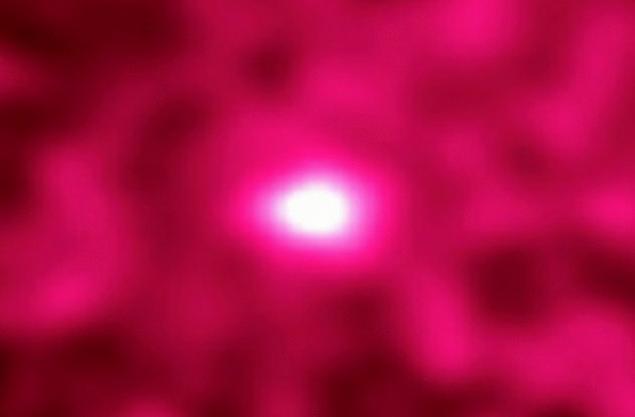
Cosmic radiation is a high energy, is not fully understood by science. One of the main mysteries of astrophysics is the origin of the ultraenergeticheskoe cosmic radiation and how it can contain such an incredible amount of energy. This is the most highly charged particles known in our Universe. Watch their movement, scientists can only when they hit the upper layers of our planet, torn into even smaller particles and causing a sharp pulse of radio waves, lasting more than a few nanoseconds.
However, on the Ground to ensure that, where do these particles is impossible. The area of the large detector detection of these particles on the Earth is only about 3,000 square kilometers, which is approximately equal to the area of the tiny state of Luxembourg. To solve this problem, scientists plan through the construction of "Square kilometer lattice" (SKA) is a highly sensitive radio interferometer, through which the Moon (Yes, our natural satellite) will turn into a giant detector of cosmic radiation.
Square kilometer grid will use the entire visible portion of the moon's surface to detect radio signals of high-energy particles. Thanks to the SKA, scientists plan to capture up to 165 events associated with high-energy particles, which, of course, many times more than they are able to do now.
"Cosmic rays of such energies are so rare that you need to have an incredibly huge detector that can collect the required amount of information with which you can really work," explains Dr. Justin Bray from the University of Southampton."But the size of the moon Eclipse any other dimensions ever built particle detectors. If we succeed, it will be the best opportunity to find out where these particles come from."Radio Silence Venus

Venus has a hot, dense, consisting of cloud atmosphere that hides its surface from the line of sight. Until now, the only way to map the surface of this planet is the radar method. When the spacecraft Magellan has visited Venus 20 years ago, scientists interested in the two mysteries of the planet, which remained unresolved until now.
The first riddle is that the higher the terrain surface of the planet, the better ("brighter") reflects the direction of the surface of the radio wave. Something similar is happening on the Ground, but with the visible light. The higher we go, the lower the temperature becomes. The higher the mountain, the more and thicker snow. A similar effect occurs on Venus, the surface of which we cannot see in visible light. Scientists believe that the cause of this effect is the process of chemical weathering, which depends on the temperature or type of precipitation of heavy metals, which act as metal caps, reflecting the radio signals.
The second mystery of Venus is the presence of radar gaps on the heights of the surface of the planet. Scientists see a poor reflection of signals at an altitude of 2400 meters, then a sharp jump in signal reflections when climbing up to 4500 meters. However, from 4700 meters there is a sharp increase in the gaps of the reflected signals. Sometimes the number of gaps in the hundreds. The signals are like in the void.
Blobs of light on the F-ring of Saturn
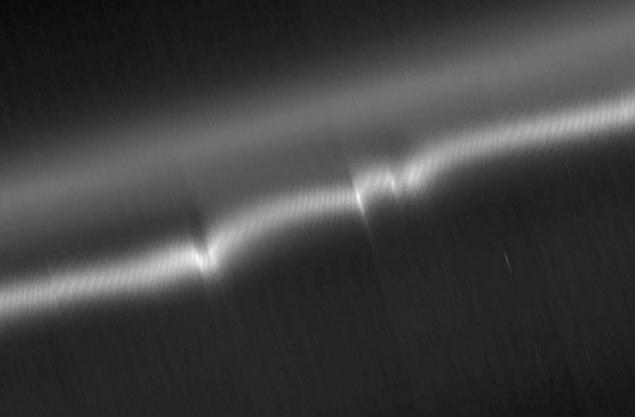
Comparing recently received by the spacecraft Cassini data with information obtained by Voyager 30 years ago, scientists found a decrease in manifestations of bright clumps in the F-ring of Saturn (although the total number of clusters remained unchanged). As researchers found, the F-ring is capable of change. At the same time do it very quickly. Actual for several days.
"This observation gives us another mystery of our Solar system, which is worth to solve," says Robert French of the SETI Institute in California. Some of the rings of Saturn are composed of ice blocks with dimensions similar to a large boulder. However, the F-ring of the planet is composed of ice particles whose size is no more than dust. For this reason, scientists are often called F-ring "dust ring". When you look at this ring will be seen the dim glow.
Sometimes ice particles near the ring are connected and form large ice coma — tiny satellites of Saturn. When these tiny satellites are faced with the bulk of the F-ring, then pushed him out of the particles that form it. The result is a bright flash. The number of these bursts depends on the number of tiny satellites. At least so says one of the theories.
According to another theory, the F-ring of Saturn formed relatively recently. And it was formed due to the destruction of a large icy satellites of the planet. In this case, changes in the F-ring occur due to its development. Scientists have not yet decided which of the theories is more like the truth. Need more observations of the F ring of the planet.
Imaginary geysers Europe
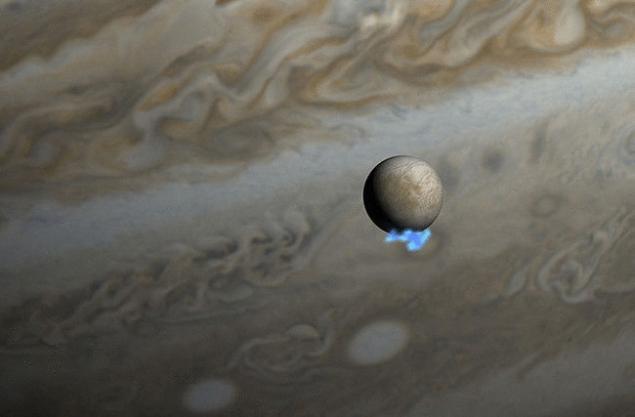
In late 2013 scientists announced that the space telescope "Hubble" found on the surface of the South pole of Europe, the icy satellites of Jupiter, rising to a height of 200 kilometers to the geysers. Suddenly, for science is the search for extraterrestrial life potentially easier. Because the Orbiter could fly through these geysers and collect samples of the oceanic part of Europe to search for signs of life and at the same time without the need of landing on the icy surface.
However, further observations of Europe showed no evidence of water vapor. Re-analysis of previously collected data generally questioned the information about whether any of these geysers. Some scholars also suggest that investigating in October 1999 and November 2012 Europe "Hubble" found no geysers.
The discovery of geysers on Europa turned into a real mystery. Space Agency NASA plans to send to the moons of Jupiter robotic probe, whose task will be to understand the reality or unreality of observation.
Methane on Mars
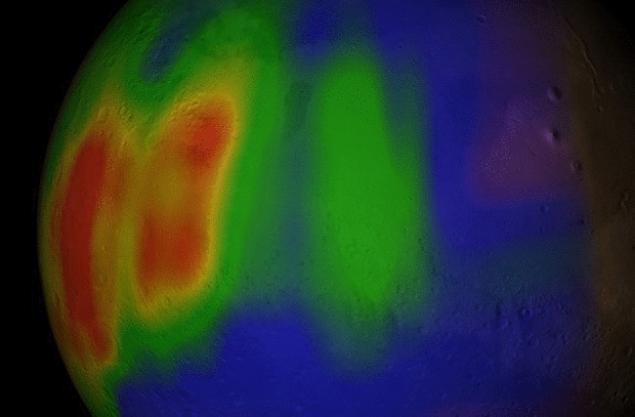
The Rover "Curiosity" since its stay on the red planet has not noticed signs of methane on Mars, but 8 months later after landing, scientists were surprised that the Rover has recorded its sensitive sensors. On Earth, more than 90 percent in the atmosphere of methane produced by living beings. For this reason, scientists in whatever was decided to find out how could take the methane on Mars and what could cause his sudden release into the atmosphere of the red planet.
According to those same researchers, there are several possible causes. One of them, for example, could be the existence on the planet, the methane-producing bacteria, or methanogens. Another likely cause can be a hydrogen-rich meteorites, which are from time to time penetrate the atmosphere of Mars and are, in fact, a kind of organic bombs that release methane when heated to extreme temperatures by ultraviolet radiation of the Sun. Theories on this question a lot and one more beautiful than the other.
The second riddle of Mars is that there is not only methane, but also disappears. When the Mars space probe failed to detect signs of methane after it originally found there, the scientists put this fact in the present impasse. If you believe the science, methane can't disappear from the planet in just a few years. The process of decomposition of the chemical from the atmosphere would require about 300 years. So the scientists have a question: was there ever really was discovered methane on Mars?
However, some of the methane emissions were indeed confirmed. As for to where he then happened: maybe Martian winds continuously distilled from the methane molecule sensitive sensors "Curiosity"? And yet this does not explain certain observations of an orbiting planet space probe.
Life on Ceres
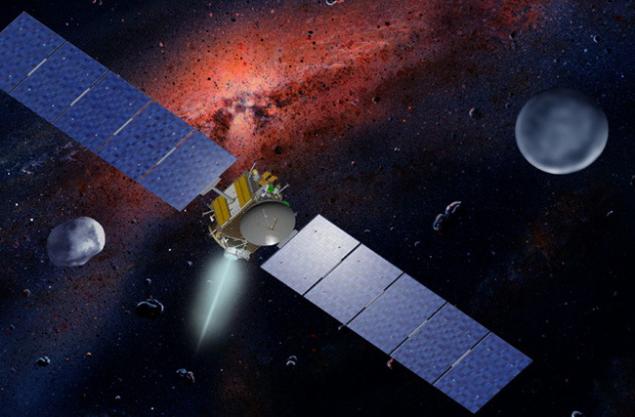
Space research unit Dawn space Agency NASA in a hurry to meet Ceres, dwarf planet located in our Solar system. To it space probe is scheduled to arrive in March 2015. Virtually everything we know about Ceres, remains a mystery to scientists. Unlike protoplanet Vesta, which Dawn visited on the way to Ceres, with Ceres not bound by any stories of meteorites and comets that could form its structure.
And while the West remains very dry asteroid is believed that Ceres is composed of rock and ice and may contain under its ice-cap, liquid ocean of water. Scientists suggest that the water in one form or another is up to 40 percent of its staff. Ceres, according to science, is the second planet (after Earth), or any other cosmic body containing such large amounts of water in our Solar system. However, the exact amount of water until scientists failed to find out. Perhaps the Dawn spacecraft will help to resolve this issue and also to answer the question of why Ceres is so different from Vesta.
Both dwarf planets may contain important information about life on Earth. And Ceres is the most mysterious. Can this protoplanet support life? As far as scientists know, there are three components necessary for life: energy source, liquid water and chemical building blocks such as carbon. Besides being on Ceres in a large volume may contain water, including in liquid form, itself, Ceres is close enough to the Sun to obtain a sufficient amount of solar heat. While science is not known whether the dwarf planet has its own internal heat source. Also, nothing is known about the availability of the necessary building blocks of life. Let's hope the space mission Dawn will be able to answer all these questions.
Source: hi-news.ru
FDA: the Majority of herbal supplements at GNC, Walmart, Walgreens contain cheap fillers
A sensor that can give a person the ability to sense magnetic fields

